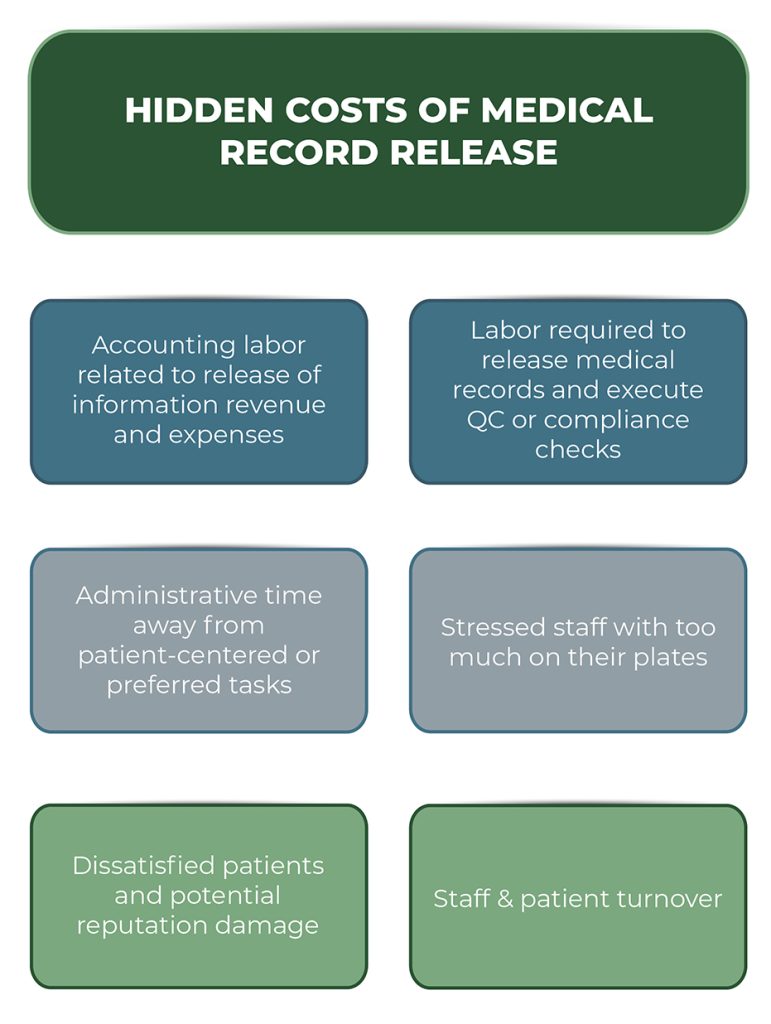Budgets. The word no one wants to talk about, across every industry and every segment. Healthcare is no different. Every healthcare organization has a budget it must follow, but what about your health information management (HIM) budget? Even if you don’t have full-time record processing staff, your records management is a cost center you must consider when thinking about your overall organizational budget.
How does the HIM budget fit into your overall organization’s budget?
Health information management should be treated like any other key section of your budget. Of course, every budget is structured differently, and we’re not accountants, so this blog isn’t going to get into the nuances of budget creation. (Not exactly our cup of tea, to be honest.) We’re going to focus on why it’s vital your organization thinks about, plans for and continues to monitor the obvious and hidden costs to managing health information, especially when it comes to health records.

Why should I account for release of information in my organization’s budgets?
If your scale demands that you have a full-time records processing team, this is likely already a big part of your annual budget planning – and that’s great. But for many organizations medical release of information management is an afterthought. It’s often a side hustle your nurses or admins are juggling between patients and other duties. And that can cause stress (and pain!) for your staff – no one wants that. Get your nurses and admins back to patient care by allocating resources for release of information budgeting.
What are the other parts of a healthcare organization budget I should consider?
We’ll go into more detail on this below, but in general, best practices for your organizational budget include everything you need to operate a functional business. A great budget facilitates your mission and vision, allowing you the flexibility and tools you need.
Four Benefits of a Thoughtful Healthcare IT & HIM Budget Plan
- When you have a clear budget and plan, you can better understand the allotment of funding for individual projects, initiatives and functional department needs
- Through your budget, you can achieve alignment between operational plans and financial goals
- Budgets allow for organizational prioritization through investments for strategic goal-driven initiatives
- Prepared budgets help your organization minimize purchasing errors and costly financial rabbit holes

Considerations for a Health Information Management/HIT Budget
When building your organization’s HIM budget, there are several factors you must consider.
- Your EHR. This is likely your highest cost center when it comes to your technology stack. As such, it deserves high priority. Another key consideration related to your EMR is how it helps or hurts your budget when it comes to point three below -data security and compliance.
- Records management. Hint, hint, this is probably costing you more than you realize. Medical records release and management is often a hidden cost center that healthcare organizations might not be thinking about. Yet this is a crucial part of your overall HIM/HIT budget. And if you aren’t thinking about it now, think about it for next budget season: how much are you really spending to release records when you consider the cost of your staff’s time, plus all of those photocopies, stamps and trips to the post office? All of that fits into this bucket!
- Data security and compliance. This is a a key component of budgets too. How are you securing your data, while in storage and in motion? (Is your EMR helping or hurting?) As our world becomes increasingly digital, ensuring you make the right investments to secure your sensitive patient data is critical.
- Staffing and training. We all know this is a tight labor market, for a variety of reasons. What are your HIM staff costing you in salary dollars as well as training and retention dollars? And how will these costs change over time?
- Integrations between software systems and departments. Interoperability is more than just a buzzword. Systems that integrate can be costly, but so are disparate solutions. Think about how much money your accounting team is allocating to drive seamless operations, even if that cost is measured in time, not specifically spend.
- Outsourced services and miscellaneous vendors. Every business needs to think about the vendors they pay for various services. When thinking specifically about HIM/HIT, this could be a third-party storage server or a technology provider who comes in to service your equipment.
- Quality assurance and auditing. Every workflow process has bumps that need fixing, and pre-planning for these crucial steps in your budget allows you to rest easy when executing them in the future.
- Telehealth factors. Are you offering or planning to offer telehealth services in the future? When it comes to your healthcare IT budget, this could be a big piece of the pie.
- System upgrades. Do you have contracts up for renewal? Or are you running on an outdated system that will be losing support soon? Either way, planning for and allocating funds to handle upgrades is key for budget success.
- Contingency and emergency considerations – outside of compliance. Yes, you need emergency plans for a major event within your EHR. Or your servers. Fixes always cost more than we think they should, so being prepared now will help your organization later.
- Revision timeline & plan. How often should you be revisiting your overall budget as well as your departmental budget for healthcare information management and technology? Probably quarterly, if not monthly. Healthcare moves fast, and so does technology. And you don’t want to be caught off guard at the end of the fiscal year.
Hidden Cost of Medical Records Release
Throughout the course of this blog, we’ve hinted at the hidden cost center associated with inhouse medical records release management. So now let’s talk about it!
The obvious costs of releasing medical records
- Any full-time staff who are devoted to medical records release, whether seasonal (think audits) or year-round
- The benefits and management of said staff
- Office supplies such as stamps, envelopes, photocopies, etc.
- Digital platform to release records, if applicable
Yes, you could be receiving revenue from third parties or even patients to cover some of the costs of releasing records. But generally, that revenue does not come close to covering all the hidden costs your organization could be dealing with.

The sneaky costs of releasing medical records
- The labor and time related to accounting and execution of requests (especially if your organization doesn’t have full-time staff)
- Time taken away from other tasks your staff should be doing (think filing, checking-in, data entry)
- Dissatisfied patients leaving negative reviews, hurting future revenue opportunities, or leaving your organization altogether
- Stressed staff choosing to leave your organization
Check out how much you could save by switching to a release of information partner!
The Benefits of Outsourcing
Outsourcing any service in healthcare can be stressful. But when it comes to medical release of information, the benefits far outweigh the concerns. From patient satisfaction scores (hint, they improve – a lot!) to risk of compliance problems (hint, they go down), the reasons your organization should consider outsourcing are strong. Check out our blog all about the seven benefits of outsourcing your release of information processes!
And we aren’t just saying that because we’re a release of information vendor. We have proof. Check out this case study about InnovaCare. By outsourcing with HealthMark, patient complaints related to medical records went down 100%. Yup, you read that right. We reduced their complaints to zip!
The Bottom Line on Healthcare IT & Information Management Budgets
No budget is easy, that’s just the truth. But if you go into your organization’s budgeting with a purposeful mindset around including HIM and HIT, you’re taking a great first step to making it easier. And if you factor in all of the considerations related to HIM and HIT, you’re making it easier still.
When it comes to budgeting for release of information, we’ve seen a thing or two – and we know a thing or two. Contact us today to talk about how we can save health professionals like yourself and your organization time and money on release of information!